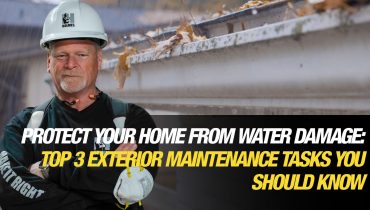When it comes to homes, water is enemy number one, and these 3 exterior home maintenance tasks will help prevent water damage. Water damage is one of the most costly...

Maintaining Outdoor Structures
By Mike Holmes
Mike’s Advice / Outdoor Renovations
Wednesday, June 15th, 2022 @ 11:57pm
Most people don’t realize that maintaining outdoor structures, like decks, porches, garages and sheds is important. Many people think that these kinds of structures are replaceable, so if they get some wear and tear it’s not a big deal; or they don’t need to be maintained since they are outside anyway. But proper maintenance on these structures is crucial to increasing and maintaining your property value, as well as protecting whatever is stored inside or on top of them.
At the end of the day, walkways, driveways, fences, decks and sheds are part of your property. If your house looks great but you have a shabby looking shed right beside it, or a worn out or overgrown walkway leading to the entrance of your home, it can really hurt the overall curb appeal.
And if you haven’t kept up with the maintenance on a shed or fence—which is usually much easier than maintaining a house—most people will assume that the maintenance on your home hasn’t been kept up either.
Bottom line: if you’re thinking of selling your house, repairing any outdoor structures on your property is a smart selling tool and a good investment.

I love my outdoor kitchen and entertainment space, it’s great for having friends and family over.
Keep Precipitation Out
Protecting outdoor structures from precipitation and moisture is crucial since they are constantly exposed to the elements—it’s unavoidable. Unfortunately, this can wear them out prematurely if they are not properly maintained.
Check Your Shed for Moisture
If precipitation is finding its way inside your shed it can damage whatever valuables you’re storing inside, including lawnmowers, furniture and tools.
You can usually tell if moisture is coming in by looking on the inside the structure. If it’s made of wood look for water damage on the ceiling and in corners, if the roof is metal check for rust around nails.
Maintain Your Deck
Do a visual inspection of your deck yourself. Check for rotting wood, wobbly stairs or railings, rot, and other signs of damage. Here is a guide to deck maintenance.
Do a Water Test!
You can verify if water is getting into a shed by spraying the roof with water and then checking inside for any leaks. If you see that water is getting in, you need to make the proper repairs, like sealing around screws with an exterior silicone.
Put these items on your checklist:
- Peeling paint & insect damage. Get rid of any wasp nests.
- Animals. Some love to make dens underneath sheds. The burrowing can undermine the soil, which can cause the structure to tip or slant.
- Worn out doors. If they’re falling apart replace them, and make sure the hinges are tight. You don’t want the doors flinging open during a storm.
- Loose windowpanes. If your shed has windows, check for loose panes and gaps in the window frame.
- Gaps. Any gaps should be sealed with caulking—rubberized is best because it lasts longer and it’s flexible. Also seal around the bottom edge of the structure, where the siding meets the concrete pad.
- Loose shingles. If the shed has a shingled roof make sure that any loose shingles are properly secured.
- Overhanging trees. Too much shade can lead to things like mould, rot and algae. Overhanging branches can also cause extra precipitation to run off onto the roof, or if they break during a storm they can damage the roof.
Is It Wood?
Outdoor structures made of wood require more maintenance. Cedar is naturally resistant insect damage and rot, whereas pressure-treated (PT) lumber is chemically treated to make it weather-resistant. Both are top choices when it comes to outdoor structures but they both require maintenance. Look for signs of water damage—things like mould and rot. If any of the wood has started to rot those boards need to be replaced. If not, you could be looking at replacing the entire structure.
Did You Know?
Nowadays you can get hot water tanks made specifically for outdoor structures, like garages, sheds and barns. These have a super thick layer of insulation, so the water doesn’t freeze in the winter. There are also frost-free hose bibs you can have installed.
Read Next: Deck Inspection and How to Check Your Deck Safety







